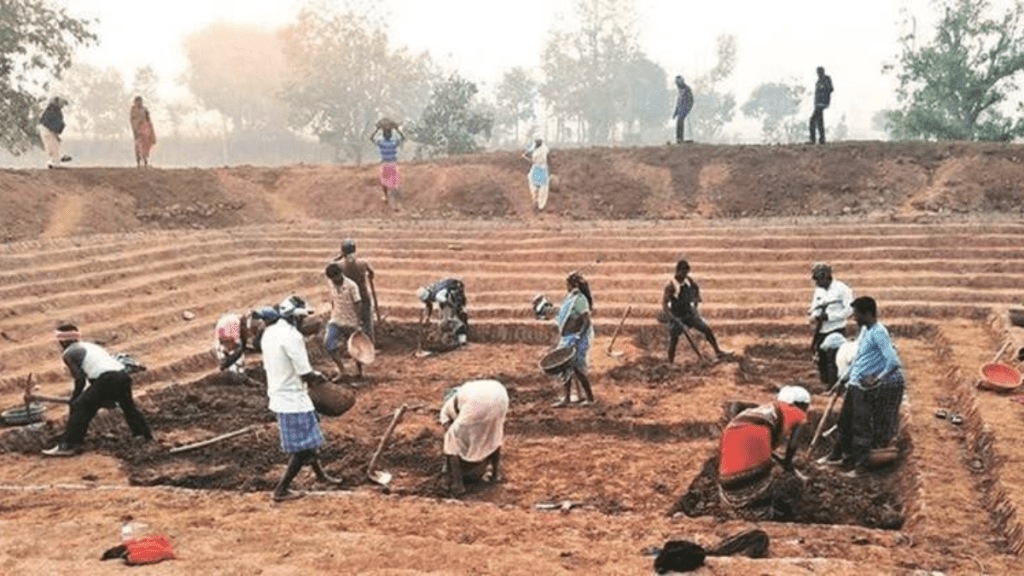The gap between demand and supply for work under the Mahatma Gandhi National Rural Employment Guarantee Scheme widened in May, as more households lined up for wage employment to supplement their income or for sustenance.
Under the MG-NREG Act (NREGA), close to 31.7 million households applied for work in May but only 22.3 million got it, data from the ministry of rural development showed.
After the pandemic years, which forced the government to scale up spending on the scheme, the disbursal of funds were apparently curbed in FY23, given a pick-up economic activities. A decline in demand for work was also evident in the last fiscal, though analysts say this may have been partly due to a slowness in accepting the registrations. The gap between employment sought and jobs provided hovered around 5 million or less in most months of FY23, but in May 2023, it touched 9.4 million.
There has been an increase in demand for NREGA work from households, which has not been met. Demand for work under NREGA has been going up, but work allotted has been going down. There is also a decline in budgetary allocation for NREGA, said senior fellow at National Council of Applied Economic Research Pallavi Choudhuri.
For 2023-24, the outlay for the scheme was brought down to `60,000 crore from last year’s `89,400 crore. In 2021-22, the actual spending on the programme was `98,468 crore, and in the pandemic year 2020-21 the spending touched an all-time high of `1.11 trillion. The government maintains that as the MG-NREGA is a demand-driven programme and funds will be provided as and when the need arises. The trend of more households seeking work has been visible since April.
Choudhuri said that the increase in demand for work under NREGA could be because of efforts of rural households to supplement their income in the face of multiple challenges. “Real wages in the rural sector have risen only marginally recently, after stagnating for a long time. Paid work situation has not improved. MG-NREGA offers an opportunity to drive income and provide cushion against shocks,” Choudhuri said.
One reason for the uptick in the number of households/persons seeking work in April-May every year is that it is a lean season for farm labour after completion of rabi harvest activities. The farm work returns with sowing for kharif, starting with the arrival of monsoon. The increase in April-May of 2023 is more than the trend seen in past years.
“PM Graib Kalyan Yojana that provided additional free food grains to every person of a household ended in December. Now, rural labourers have to go to the market to buy additional foodgrains to meet the demand beyond what they get under PDS. This too could be the other reason for more people seeking employment under MG-NREGA,” Choudhuri said. “Paid work situation has not improved in rural areas. The Periodic Labour Force Survey shows increasing trend towards self-employment. But that self-employment has been in subsistence farming,” she said. “NREGA offers the opportunity for creation of assets on individual plots of land that can go on to boost productivity. This could be the other reason for higher demand for work under the scheme,” Choudhuri added.
MG-NREGA is the government’s flagship scheme that aims to provide 100 days of guaranteed wage employment to one person from every household who volunteers to do unskilled manual work.
For this year, wages have been set in the range of `357 per day to `221 per day.
The number of people who availed employment under MG-NREGA declined by 16.9% in 2022-23 from a year ago. According to official data, about 102.5 million people demanded work under the scheme in FY23 as against 123.4 million in FY24. Meanwhile, the number of people who availed work under the scheme also declined by 17.4% to 87.6 million in FY23 as against 106.1 million in FY22. In FY21, the number of people who demand and availed employment under the scheme was even higher at 133.1 million and 11.9 million respectively.
The average number of households that completed 100 days of work also fell substantially to 3.6 million last fiscal from 5.9 million in FY22.
